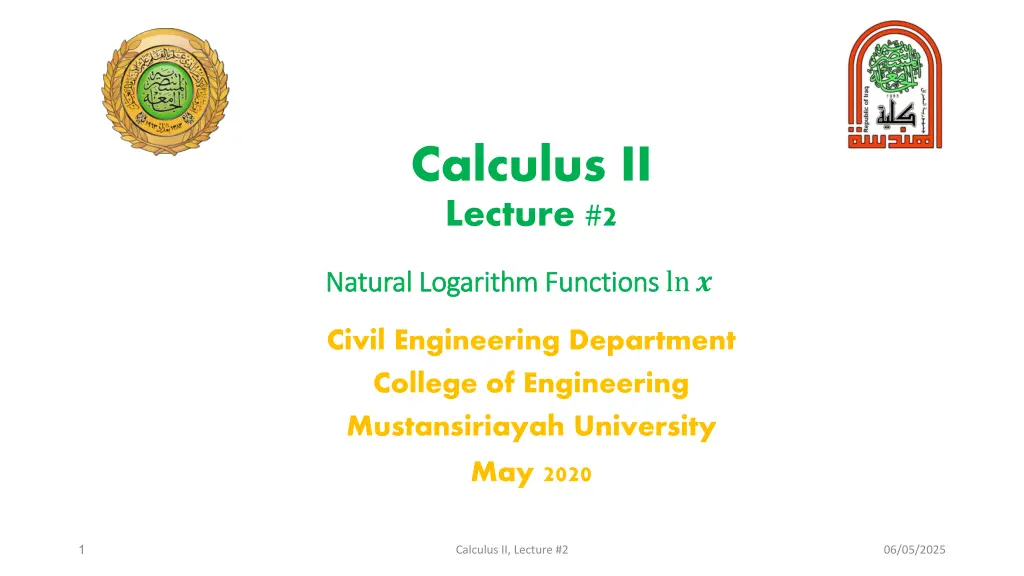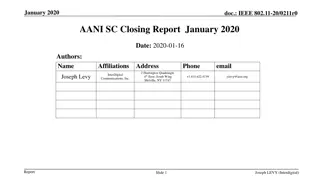
Understanding Natural Logarithm Functions in Calculus II
Explore the definition, derivative, and algebraic properties of natural logarithm functions in Calculus II. Learn about integral rules, derivative calculations, and applications of logarithms in various functions. Discover how to interpret and apply logarithmic properties to solve mathematical problems.
Download Presentation

Please find below an Image/Link to download the presentation.
The content on the website is provided AS IS for your information and personal use only. It may not be sold, licensed, or shared on other websites without obtaining consent from the author. If you encounter any issues during the download, it is possible that the publisher has removed the file from their server.
You are allowed to download the files provided on this website for personal or commercial use, subject to the condition that they are used lawfully. All files are the property of their respective owners.
The content on the website is provided AS IS for your information and personal use only. It may not be sold, licensed, or shared on other websites without obtaining consent from the author.
E N D
Presentation Transcript
Calculus II Lecture #2 Natural Logarithm Functions Natural Logarithm Functions ln? Civil Engineering Department College of Engineering Mustansiriayah University May 2020 1 Calculus II, Lecture #2 06/05/2025
Definition of the Natural Logarithm Function Definition of the Natural Logarithm Function The natural logarithm of a positive number x, written as ln x, is defined as an integral. ?1 ln? = ???, ? > 0 1 From the Zero Width Interval Rule for definite integrals, we also have: 11 ln1 = ??? = 0 1 x 0 0.05 0.5 1 2 3 4 10 ln x undefined -3 -0.69 0 0.69 1.10 1.39 2.3 2 Calculus II, Lecture #2 06/05/2025
The Derivative of y= The Derivative of y= ln ln x x ?1 ? ??ln? = ? ?? ??? =1 ? 1 For every positive value of x, we have: ? ??ln? =1 ? If u is a differentiable function of x whose values are positive, so that ln u is defined, then applying the Chain Rule we obtain: ? ??ln? =1 ?.?? ?? 3 Calculus II, Lecture #2 06/05/2025
Inverse Functions Inverse Functions Example 1: Find derivatives of the following functions: ? ??ln2? = 2?2 =1 1 ? Notice from Example 2a that the function ? = ln 2? has the same derivative as the function ? = ln ?. ? ??ln ?2+ 3 = 1 2? ?2+32? = ?2+3 ? ??ln ? , ? 0 1 ?.? ? ?2=1 = ? ? ? ? Notice that the derivative of ? = 1 = 4 Calculus II, Lecture #2 06/05/2025
Algebraic Properties of the Natural Logarithm For any numbers b > 0 and x > 0, the natural logarithm satisfies the following rules: Product Rule: ln ?? = ln ? + ln ? Quotient Rule: ln? ?= ln ? ln ? Reciprocal Rule: ln1 ?= ln? Power Rule: ln??= ? ln ? For r rational 5 Calculus II, Lecture #2 06/05/2025
Example 2: Interpreting the properties of Logarithms ln6 = ln 2 3 = ln2 + ln3 ln4 ln5 = ln4 5= ln0.8 ln1 8= ln8 = ln23= 3ln2 Example 3: Applying the properties of Logarithms to function formulas ln4 + ln sin? = ln 4sin? ?+1 2? 3= ln ? + 1 ln 2? 3 ln sec? =ln cos ?= lncos? ln ln 1 3? + 1 = ln ? + 11/3=1 3ln ? + 1 6 Calculus II, Lecture #2 06/05/2025
The Integral (?/?)?? If u is a differentiable function that is never zero, then: 1 ??? = ln ? + ? Whenever ? = (?) is a differentiable function that is never zero, we have that ?? = (?) ?? and: ? (?) ?(?)?? = ln ?(?) + ? 7 Calculus II, Lecture #2 06/05/2025
Example 4: Calculate the following integral: ? 2 4cos? 3 + 2sin??? ? 2 Let: ? = 3 + 2sin?,?? = 2cos? Therefore, 52 5= 2ln 5 2ln 1 = 2ln5 ??? = 2ln ? 1 1 The Integrals of ??? ?,????,????,??????? To integrate these trigonometric functions, tan? ?? = sin? 1 cos??? = ln cos? + ? = ln cos?+ ? = ln sec? + ? cot? ?? = cos? sin??? = ln sin? + ? = ln csc? + ? 8 Calculus II, Lecture #2 06/05/2025
Derivatives of Inverse of Differentiable Functions Derivatives of Inverse of Differentiable Functions To integrate sec x, we multiply and divide by (sec x + tan x) as an algebraic form of 1. sec? + tan??? = sec2? + sec?tan? sec? ?? = sec?.sec? + tan? sec? + tan? = ln sec? + tan? + ? For csc x, we multiply and divide by (csc x + cot x). csc? + cot??? = csc2?+csc?cot? csc? ?? = csc?.csc? + cot? csc? + cot? = ln csc? + cot? + ? 9 Calculus II, Lecture #2 06/05/2025
Example 5: Calculate the following integral: ?/6 tan2??? = ?/3 ?/3 ?/3 tan??? 2=1 1 2ln sec? 2 tan??? = 0 0 0 0 =1 2ln2 ln1 =1 2ln2 Example 6: Using the Logarithmic Differentiation, find dy/dx if: ?2+ 1 ? + 31/2 ? = , ? > 1 ? 1 Solution: the Natural logarithm of both sides is taken: ?2+ 1 ? + 31/2 ? 1 ln? = ln ln? = ln ?2+ 1 ? + 31/2 ln ? 1 ln? = ln ?2+ 1 + ln ? + 31/2 ln ? 1 ln? = ln ?2+ 1 +1 2ln ? + 3 ln ? 1 10 Calculus II, Lecture #2 06/05/2025
The derivatives of both sides are taken with respect to x: 1 ?.?? ?2+ 1.2? +1 1 1 1 ??= 2. ? + 3 ? 1 Then, solve for ??/??: ?? ??= ? 2? 1 1 ?2+ 1+ 2? + 6 ? 1 Finally, substitute the function of y: ?2+ 1 ? + 31/2 ? 1 ?? ??= 2? 1 1 ?2+ 1+ 2? + 6 ? 1 11 Calculus II, Lecture #2 06/05/2025
Example Example 7 7: Using the Logarithmic Differentiation, find dy/dx if: ? = ln?.1 ?. ? Solution: the Natural logarithm of both sides is taken: ln? = ln ln?.1 ?. ? ln? = ln ln? + ln1 ?+ ln ? ?+1 1 ?2 1 ? ?.ln? 1 1 ?.ln? ln? = ln ln? + ln1 2ln? 1 ? 1 ?.?? +1 2.1 ??= ln?+ ? 1 ?.?? ?? ??= ?. 1 1 ??= ?+ 2? 1 2? Finally, substitute the function of y: ?? ??= ln?.1 1 1 ?. ? . ?.ln? 2? 12 Calculus II, Lecture #2 06/05/2025
Homework Homework Use the properties of the natural logarithms to simplify the following expressions: sin ? 5 lnsin? ln 1 ln 3?2 9? + ln 3? 1 2ln 4?4 ln2 Find the first derivative of the following functions with respect to x: ? = ln?3 10 ? ? = ln ? = ln ln(ln? ) Evaluate the following integrals: 0 3 ?? 3? 2 1 sec ? ?? ln sec ?+tan ? 13 Calculus II, Lecture #2 06/05/2025



















